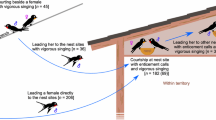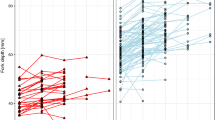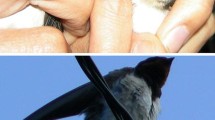Abstract
MANY secondary sexual characters are supposed to have evolved as a response to female choice of the most extravagantly ornamented males1, a hypothesis supported by studies demonstrating female preferences for the most ornamented males2–5. Comparative studies of elaborate feather ornaments in birds have shown that (1) ornaments have larger degrees of fluctuating asymmetry6 (small, random deviations from bilateral symmetry caused by an inability of individuals to cope with environmental and genetic stress during development of a character7) than other morphological traits, and (2) the degree of fluctuating asymmetry is often negatively related to the size of the ornament6. The negative relationship between ornament asymmetry and size suggests that ornament size reliably reflects male quality because the largest secondary sex traits demonstrate the least degree of fluctuating asymmetry. I manipulated tail length and tail asymmetry independently in male swallows (Hirundo rustica) to determine whether ornament size or asymmetry were used as cues in mate choice. Male swallows with elongated, symmetric tails mated earlier, and enjoyed larger annual reproductive success than did males with shortened tails and increased asymmetry. Females therefore prefer large as well as symmetric ornaments, which suggests that females in their mate choice use ornament asymmetry and size as reliable indicators of male quality.
Similar content being viewed by others
References
Darwin, C. The Descent of Man and Selection in Relation to Sex (Murray, London, 1871).
Andersson, M. Nature 299, 818–820 (1982).
Møller, A. P. Nature 332, 640–642 (1988).
Smith, H. G. & Montgomerie, R. D. Behavl Ecol Sociobiol. 28, 195–201 (1990).
Petrie, M., Halliday, T. R. & Sanders, C. Anim. Behav. 41, 323–331 (1990).
Møller, A. P. & Höglund, J. Proc. R. Soc. B 245, 1–5 (1991).
Ludwig, W. Das Rechts-Links Problem im Tierreich und beim Menschen (Springer, Berlin, 1932).
Møller, A. P. Anim. Behav. 40, 1185–1187 (1990).
Møller, A. P. Anim. Behav. 39, 458–465 (1990).
Møller, A. P. Proc. R. Soc. B 243, 59–62 (1991).
Palmer, A. R. & Strobeck, C. A. Rev. Ecol. Syst. 17, 391–421 (1986).
Parson, P. A. Biol. Rev. 65, 131–145 (1990).
Trivers, R. L. in Sexual Selection and the Descent of Man, 1871–1971 (ed. Campbell, B.) 136–179 (Aldine, Chicago, 1972).
Zahavi, A. J. theor. Biol. 53, 205–214 (1975).
Kirkpatrick, M. & Ryan, M. J. Nature 350, 33–38 (1990).
Author information
Authors and Affiliations
Rights and permissions
About this article
Cite this article
Møller, A. Female swallow preference for symmetrical male sexual ornaments. Nature 357, 238–240 (1992). https://doi.org/10.1038/357238a0
Received:
Accepted:
Issue Date:
DOI: https://doi.org/10.1038/357238a0
- Springer Nature Limited
This article is cited by
-
Perceptual grouping and detection of trial-unique emergent structures by pigeons
Animal Cognition (2022)
-
A recent invasive population of the European starling sturnus vulgaris has lower genetic diversity and higher fluctuating asymmetry than primary invasive and native populations
Biological Invasions (2022)
-
Source dipole analysis reveals a new brain response to visual symmetry
Scientific Reports (2021)
-
Symmetry perception with spiking neural networks
Scientific Reports (2021)
-
What is Beauty?
Aesthetic Plastic Surgery (2021)





